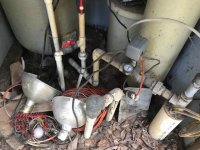My existing pressure tank has failed & I I have a replacement on hand. It looks like I will have to cut the PVC to remove the old one. There is no drain or pressure release in the circuit, so I am wondering if I have to worry about trapping air in the tank. This question probably exposes my ignorance of how the system works, but I promise I can learn things & I have an understanding of physics & mechanics  .
.
Replacing pressure tank. Do I need to worry about trapping air?
- Thread starter Bugeyed
- Start date

